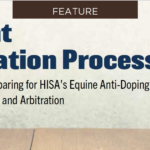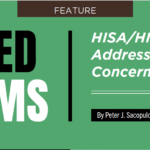By Clara Fenger, DVM, PhD, DACVIM; Peter J. Sacopulos, JD; Kimberly Brewer, DVM, MSc; Jacob Machin, MS; and Thomas Tobin, MRCVS, PhD, DABT
 The relationship between the Food and Drug Administration and the Horseracing Integrity and Safety Authority is complicated, to say the least. To help clear up some of the confusion, our team discussed the relationshipand some potential issues with Joseph J. Bertone, DVM, MS, DACVIM, Professor Emeritus of Equine Internal Medicine at Western University of Health Sciences and former reviewer at the FDA’s Center for Veterinary Medicine.
The relationship between the Food and Drug Administration and the Horseracing Integrity and Safety Authority is complicated, to say the least. To help clear up some of the confusion, our team discussed the relationshipand some potential issues with Joseph J. Bertone, DVM, MS, DACVIM, Professor Emeritus of Equine Internal Medicine at Western University of Health Sciences and former reviewer at the FDA’s Center for Veterinary Medicine.
ACCORDING TO DR. JOSEPH BERTONE, OWNERS OF RACEHORSES AND VETERINARIANS MUST DEFER DECISIONS ABOUT INDIVIDUAL ANIMAL CARE TO AN ABSENTEE REGULATORY GROUP— IN THIS CASE THE HORSERACING INTEGRITY AND SAFETY AUTHORITY—THAT IS UNABLE TO EXAMINE THE HORSE.
Bertone received his DVM and BS degrees (nutrition concentration) from Cornell University and completed an internal medicine residency training program and an MS degree at Colorado State University. He previously served on the faculties of Louisiana State University and Ohio State University and was an FDA veterinary medical officer and pharmacology fellowship trainee. He has been seated on multiple American Association of Equine Practitioners (AAEP) committees and served on the Drug Compounding Task Force. He also served on the American Veterinary Medical Association (AVMA) Council on Biologic and Therapeutic Agents and was endorsed for this position by the AAEP. In addition, he served on the AVMA Steering Committee for Antimicrobial Resistance.
The Horsemen’s Journal: The Horseracing Integrity and Safety Authority (HISA) places a lot of emphasis on Food and Drug Administration (FDA) approval of drugs in its new regulations. What is the relationshipbetween HISA and the FDA?
Joseph Bertone: Before we can investigate where the HISA medication rules are related to the FDA regulations, we need to first understand what the FDA does. The purpose of the FDA is to provide people and animals with effective and safe drugs, food and medical devices and to act as a defense from sham and dangerous health practices.
The first federal law regulating food and drugs was the Pure Food and Drug Act of 1906, which defined “misbranding” and “adulterated” for the first time and eventually led to the establishment of the United States Food and Drug Administration in 1930. The rules under which the FDA operates were laid out in the Food, Drug and Cosmetic Act of 1938 and are found in the Code of Federal Regulations Title 21. “Mislabeling” was later added to safeguard the public against misleading advertisement.
In general, the FDA protects public health by regulating all human and animal food and drug products offered in interstate commerce. In the case ofdrugs, the FDA determines the marketing status (labeled drug claims) via its approval process, requires registration of all drug manufacturing facilities and requires that all manufactured drugs are produced in accordance with current good manufacturing practice (CGMP). The FDA inspects drug manufacturing facilities on a regular basis and reviews all procedures conducted within those facilities and also reviews labels. All this ensures that products are not misbranded, adulterated or mislabeled.
In the case of food/feed, the FDA determines what constitutes food and what may be added to food, works with the Association of American Feed Control Officials and requires that all human and animal food is manufactured under CGMP conditions. All food and supplements are regulated by the FDA. Compounded medications are generally regulated at the level of the state pharmacy boards, and there is no aspiration that compounding pharmacies meet the standards of CGMP. Hence, compounded drugs are and should be viewed as filling special needs.
HJ: What does FDA approval mean?
JB: FDA approval of drugs means that they are safe, efficacious and manufactured under CGMP conditions. CGMP assures consistency from bottle to bottle, tube to tube, pill to pill, etc., so as to provide the greatest assurance that what is on or in the bottle is represented by the label and all marketing materials and has controlled unbiased scientific proof of efficacy.
HJ: Are drugs that are not FDA approved unregulated?
JB: No. FDA approval indicates what can go on the label and how it is marketed. All drugs (Drug Listing Act of 1972) must be listed with the FDA and manufactured in a registered manufacturing facility. Registered drug manufacturing facilities are inspected by the FDA on a regular basis for conformity with CGMP to assure identity, strength, quality, purity and potency of the product. All drugs must be manufactured to CGMP standards, and this includes both listed and approved products. The FDA regulates what can be stated on the label of approved drugs, listed drugs, supplements and even compounded medications.
HJ: Does the FDA regulate compounded medications?
JB: Absolutely. Compounded medications are primarily regulated by state boards of pharmacy. The FDA provides recommendations for compounded medications (Guidance for Industry #256), which include guidelines for labeling.
Compounded medications cannot be legally marketed. However, this does not mean that they are illegal for use in animals. To the contrary, even the FDA has indicated that compounded medications are appropriate where there is a “need for such drugs when no FDA-approved or -indexed drug is medically appropriate to treat the animal.” The FDA may initiate enforcement action when compounding pharmacies act in any way to market their formulations when FDA-approved products exist for the use or when safety concerns arise, etc. Prescriptions for compounded medications that are patient-specific and prescribed in the context of a veterinarian-client-patient relationship (VCPR) are not subject to enforcement action by the FDA. The areas where the FDA intends to take action include: (1) drugs that pose human or animal safety concerns; (2) drugs administered to food animals; (3) copies of marketed FDA-approved products; and (4) non-patient-specific or office stock drugs.
HJ: Is there a manner in which equine veterinarians may use “office stock” compounded medications?
JB: Yes. The typical veterinary use of “for office use” compounded medications is when veterinarians purchase quantities of a compounded product that they expect to use in a reasonable time frame (say two to four weeks) and dispense or administer to their patients. A typical day on the racetrack may begin at 5 a.m. with pre-workout Lasix (approved formulation) and other treatments, such as antibiotics, post-workout endoscopies, routine lameness and health examinations, etc. Among the compounded medications they may use are various compounded versions of FDA-approved medications when the FDA-approved version is unavailable, including L-arginine, methocarbamol, glycopyrrolate and others. These substances are acquired as “office use” and dispensed by the pharmacy to the veterinarian, who administers them to the horse and keeps the original bottle in their possession.
Also, if a veterinarian diagnoses a condition in a horse, they will dispense off their vehicle a supply (usually a week to a month) for the patient and may order it specifically for that patient if more is needed (known as patient-specific compounding). This use is reasonable, complies with FDA guidance and is associated with the submission of a medication report to HISA as well as to the regulatory veterinarian in many jurisdictions.
HJ: Do you see a conflict between current federal and state regulations regarding the use of medications in equine practice and HISA? HISA regulations state: “Any pharmacological substance that (i) is not addressed by Rules 4112 through 4117 (lists of banned substances), (ii) has no current approval by anygovernmental regulatory health authority for veterinary or human use, and (iii) is not universally recognized by veterinary regulatory authorities as a valid veterinary use, is prohibited at all times.”
JB: This is very concerning. This statement suggests that “regulatory authorities” need to be universally in agreement that a medicament is valid. Under this scheme, both owners and veterinarians must defer decisions about individual animal care to an absentee regulatory group that is unable to examine the horse.
HJ: As the new HISA rules regarding compounding are set to go into effect January 1, can you offer any advice to veterinarians and horsemen and women about how best to comply with the new regulations?
JB: HISA regulations are a major change in how veterinary practice is regulated in the horse racing environment. While I have no special insight into how the individual regulators of HISA intend to interpret and enforce their own rules, I can certainly offer general guidelines into how the FDA views compounding.
HISA clarifies their regulations by referencing the FDA’s non-legally binding guidance on compounding:
“For the avoidance of doubt, compounded products compliant with the Animal Medicinal Drug Use Clarification Act (AMDUCA) and the FDA Guidance for Industry (GFI) #256 (Compounding Animal Drugs from Bulk Drug Substances) are not prohibited under this section S0.”
This statement by HISA takes a non-legally binding document and codifies it into a federal regulation, exceeding the intention of the FDA itself. However, taken at its face, the FDA guidance affords veterinarians wide latitude to prescribe a compounded medication over an FDA-approved medication for a patient-specific use as long as it is based on a medical and not economic rationale. Additional restrictions are placed on office stock compounds, such as limiting these products to its “List of Bulk Drug Substances for Compounding Office Stock Drugs for Use in Nonfood-Producing Animals,” which includes substances both on the list and those currently under review. The take home message from the FDA on this issue is that to be compliant, racetrack veterinarians need to:
- Use FDA-approved medications when available and medically appropriate.
- Purchase only the compounded medications expected to be used in a short (two- to four-week) period.
- Regularly check to determine the availability of backordered FDAapproved medications.
- Dispense very limited quantities of office stock compounded medications and reorder refills as patient-specific versions of the same medication.
As state pharmacy and veterinary medical boards sometimes have further restrictions (such as the restriction of the dispensing of a compounded medication to a two-week supply), it is also important that veterinarians check with the requirements of the states in which they practice.
For further information, check out the following websites:
- GFI #256: https://www.fda.gov/regulatory-information/search-fdaguidance-documents/cvm-gfi-256-compounding-animal-drugs-bulkdrug-substances
- Animal Drug Compounding: https://www.fda.gov/animal-veterinary/ unapproved-animal-drugs/animal-drug-compounding
What is evident is that this may be a complicated issue. Horse owners and trainers need to be fully aware as the rules can and have been variably interpreted. This has affected the patient, as well as the livelihood of those involved with the health and care of horses. HJ
To read more of the Questions and Answers with Joseph Bertone and The Horsemen’s Journal : download the publication in full – Winter 2022, Horseman’s Journal






